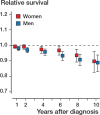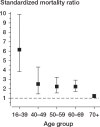Increased mortality after upper extremity fracture requiring inpatient care
- PMID: 25909341
- PMCID: PMC4564776
- DOI: 10.3109/17453674.2015.1043833
Increased mortality after upper extremity fracture requiring inpatient care
Abstract
Background and purpose: Increased mortality after hip fracture is well documented. The mortality after hospitalization for upper extremity fracture is unknown, even though these are common injuries. Here we determined mortality after hospitalization for upper extremity fracture in patients aged ≥16 years.
Patients and methods: We collected data about the diagnosis code (ICD10), procedure code (NOMESCO), and 7 additional characteristics of 5,985 patients admitted to the trauma ward of Central Finland Hospital between 2002 and 2008. During the study, 929 women and 753 men sustained an upper extremity fracture. The patients were followed up until the end of 2012. Mortality rates were calculated using data on the population at risk.
Results: By the end of follow-up (mean duration 6 years), 179 women (19%) and 105 men (14%) had died. The standardized mortality ratio (SMR) for all patients was 1.5 (95% CI: 1.4-1.7). The SMR was higher for men (2.1, CI: 1.7-2.5) than for women (1.3, CI: 1.1-1.5) (p < 0.001). The SMR decreased with advancing age, and the mortality rate was highest for men with humerus fractures.
Interpretation: In men, the risk of death related to proximal humerus fracture was even higher than that reported previously for hip fracture. Compared to the general population, the SMR was double for humerus fracture patients, whereas wrist fracture had no effect on mortality.
Figures




Similar articles
-
Increased mortality after lower extremity fractures in patients <65 years of age.Acta Orthop. 2016 Dec;87(6):622-625. doi: 10.1080/17453674.2016.1210533. Epub 2016 Sep 12. Acta Orthop. 2016. PMID: 27615323 Free PMC article.
-
Orthopaedic injuries associated with hip fractures in those aged over 60 years: a study of patterns of injury and outcomes for 1971 patients.Injury. 2012 Jul;43(7):1131-4. doi: 10.1016/j.injury.2012.03.012. Epub 2012 Mar 30. Injury. 2012. PMID: 22465517
-
Incidence of fractures requiring inpatient care.Acta Orthop. 2014 Sep;85(5):525-30. doi: 10.3109/17453674.2014.908340. Epub 2014 Apr 3. Acta Orthop. 2014. PMID: 24694275 Free PMC article.
-
A review of upper limb injuries in bear maul victims: Consistent pattern and inverse relation in severity with facial and scalp injuries.Chin J Traumatol. 2018 Feb;21(1):38-41. doi: 10.1016/j.cjtee.2017.11.001. Epub 2017 Nov 24. Chin J Traumatol. 2018. PMID: 29402720 Free PMC article. Review.
-
On the Diagnosis of Dislocations and Fractures of the Upper Extremity of the Humerus.Med Chir Rev. 1829 Jan 1;10(19):133-144. Med Chir Rev. 1829. PMID: 29919273 Free PMC article. Review. No abstract available.
Cited by
-
Increased all-cause mortality following proximal humerus fractures in Danish adults: a register-based matched cohort study of 93,952 fracture cases and 469,760 controls.Osteoporos Int. 2025 Aug 22. doi: 10.1007/s00198-025-07629-4. Online ahead of print. Osteoporos Int. 2025. PMID: 40844609
-
Exploring Goals and Functional Changes in Reablement for People with Fractures and People with Dizziness and Balance Problems.J Multidiscip Healthc. 2023 Aug 15;16:2323-2337. doi: 10.2147/JMDH.S417883. eCollection 2023. J Multidiscip Healthc. 2023. PMID: 37601327 Free PMC article.
-
Impact of osteoporotic fracture type and subsequent fracture on mortality: the Tromsø Study.Osteoporos Int. 2020 Jan;31(1):119-130. doi: 10.1007/s00198-019-05174-5. Epub 2019 Oct 26. Osteoporos Int. 2020. PMID: 31654084
-
Mortality After Complex Displaced Proximal Humerus Fractures in Elderly Patients: Conservative Versus Operative Treatment With Reverse Total Shoulder Arthroplasty.Geriatr Orthop Surg Rehabil. 2018 Sep 11;9:2151459318795241. doi: 10.1177/2151459318795241. eCollection 2018. Geriatr Orthop Surg Rehabil. 2018. PMID: 30214828 Free PMC article.
-
Mortality after Sustaining Skeletal Fractures in Relation to Age.J Clin Med. 2022 Apr 21;11(9):2313. doi: 10.3390/jcm11092313. J Clin Med. 2022. PMID: 35566441 Free PMC article.
References
-
- Abrahamsen B, van Staa T, Ariely R, Olson M, Cooper C. Excess mortality following hip fracture: A systematic epidemiological re... . Osteoporos Int. 2009;20(10):1633–50. - PubMed
-
- Barrett JA, Baron JA, Beach ML. Mortality and pulmonary embolism after fracture in the elderly . Osteoporos Int. 2003;14(11):889–94. - PubMed
-
- Bliuc D, Nguyen ND, Milch VE, Nguyen TV, Eisman JA, Center JR. Mortality risk associated with low-trauma osteoporotic fracture and subs... . JAMA. 2009;301(5):513–21. - PubMed
-
- Center JR, Nguyen TV, Schneider D, Sambrook PN, Eisman JA. Mortality after all major types of osteoporotic fracture in men and wome... . Lancet. 1999;353(9156):878–82. - PubMed
-
- Deakin DE, Boulton C, Moran CG. Mortality and causes of death among patients with isolated limb and pelv... . Injury. 2007;38(3):312–7. - PubMed
Publication types
MeSH terms
LinkOut - more resources
Full Text Sources
Other Literature Sources
Medical
